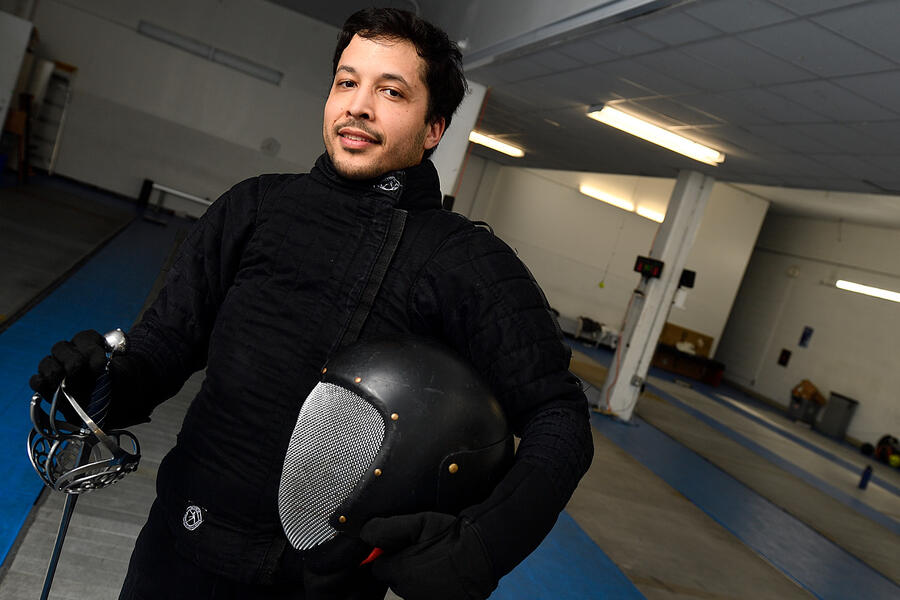My Other Life is an At Work series that lets us get to know our Johns Hopkins colleagues better. Do you or one of your co-workers have a personal passion that would make a good story? Let us know at hubatwork@jhu.edu. Want to read more of the series? Go here.
Before Diego Javier Luis talks about fencing, he wants to tell you about Wing Chun, a fighting discipline he has been practicing since he was a toddler. He's been fencing for only about 18 months but sees it as connected to Wing Chun because the combat sport and martial art share many philosophical ideals and physical characteristics.
"You learn to fight so you never have to use it," he says of Wing Chun. "It forces you to really respect anyone's capacity to be violent. I've been fortunate to never have needed to use martial arts to defend myself. It is always better to walk away or escape than to fight. So, in a way, being a martial artist has made me a pacifist. Early modern fencing is grounded in a similar approach."
Luis, who joined Johns Hopkins University last summer, is the Rohrbaugh Family Assistant Professor of History in the Krieger School of Arts and Sciences. He studies the colonial histories of Latin America and the Pacific World, race making, and Afro-Asian diasporic convergences, specializing in the connections between Mexico and the Philippines during the Manila Galleon period of 1565–1815 and the early modern Spanish empire.
His first book, The First Asians in the Americas: A Transpacific History, was published recently by Harvard University Press, and he is working on three others, including the manuscript of his grandmother's memoir that traces the history of his family from enslavement in Cuba during the 19th century to migration to the United States from the 1940s to the 1980s.
And fencing now has a role in it. His new academic work focuses on the study of early modern fencing in the colonial context, one of the reasons he decided to take up the sport. "I wanted to be able to write about how people in the Spanish colonies practiced fencing but do it as a practitioner—as someone who understands the movement as well as its history," he says.
He also is a game designer who has created a "role playing" board game with a narrative "that simulates life as a marginalized colonial subject in Mexico during the 17th century," he explains. "The object is to try to achieve some measure of social mobility, and [it] demonstrates how difficult it was to control the trajectory of one's life in colonial Mexico. You have to strategize, but you can't determine what the outcome of your decision will be."
Long before he become a historian, and even longer before taking up fencing, he learned Wing Chun from his father, in part to feel confident about his mixed heritage—Chinese and Cuban—when growing up in Nashville, Tennessee, an environment not always friendly to those who look "different." His father had also first learned martial arts as a response to his childhood environment, living in the 1950s and early 1960s on Manhattan's Lower East Side, just north of Chinatown, where Luis' Chinese grandfather owned a laundromat. That climate is what prompted his father to look toward martial arts to build self-esteem and protect himself.
"It was one of the first things my dad started teaching me when I was growing up," he recalls. "I experienced a lot of racism, and we would practice Wing Chun together. It was more than just learning how to fight and defend myself or its lofty ideals, like being an honorable person. It was also about getting in touch with a side of my heritage that felt distant and [about] deepening the connection with my father. It's something we've shared my whole life. He's turning 77 this year, and we still practice together." He laughs, adding: "He's dangerous."
Luis' grandfather was from Guangdong province on China's southeast coast, where Wing Chun has its origins. During the early 20th century, he moved to Cuba, where he met Luis' grandmother—an Afro-Cuban woman—in Havana. They moved to New York City in the mid-1940s, got married, and had his father.
It's not as unusual as it might seem that Luis has a Latino-sounding surname with a Chinese grandfather. "When my grandfather came to Cuba, his Chinese name was Hispanicized, like those of most other Chinese immigrants," he explains. "So, his Chinese family name was ?, which is pronounced like Lui in his Taishanese dialect and like Lei in the more conventional Mandarin. Lui became Luis in Cuba."
As a side note, "people with our family name who went to the U.S. were often called Louis," he adds. "So, that's how I have three first names in Spanish, since Luis is a first name and rarely a last name, except among Chinese Latin Americans."
Wing Chun is one of the threads that runs through his family story. It's a Southern Chinese martial art that involves close quarters contact and is known for its rapid punches and efficient movements.
"It was designed to allow a smaller woman to fend off aggressive suitors in close quarters," Luis explains. "It's characterized by quick hand movements and using body mechanics and leverage instead of brute force and strength. It's a very scientific style that takes the shortest distance between two points."
He has taken much of the wisdom of Wing Chun and applied the same ideals and commitment to the skills he now is learning in historical European martial arts, or HEMA, which seek to recover fencing styles that date back to the period between the 1300s and 1800s, when fencing was viewed and treated as a science, taught at universities, and considered a part of normal life, as many people carried swords with them.
It's not the same as the modern Olympic fencing seen at the Paris Games—the foil, the épée, and saber—where each fencer uses a different weapon and each discipline has its own unique rules.
Rather, it's the historical antecedent. Several styles use a two-handed longsword; others use a rapier, a one-handed sword that is longer and thicker than modern Olympic swords. Some fencers even use a rapier in one hand and a dagger in the other, not a combination viewers will ever see in the Olympics, he says. HEMA also has sabers, but they are thicker and heavier than modern Olympic sabers.
The gear worn by the fencer is similar to that of modern Olympic fencers "but with slightly more padding because the swords are thicker and you can be hit harder," he says.
Fencing during the Renaissance in Europe was considered a science and studied like a science, he says. "It emerged from mathematical principles of geometry and the relationship between intersecting lines and understanding the geometric relationship between two bodies and two lines," he says, not unlike Wing Chun.
"Rapier fencing and Wing Chun are extremely similar because both rely on body mechanics and leverage over force," he says. "It's the leverage of your sword against the opponent's sword and finding the path of least resistance to reaching your opponent. That's what I do the most—rapier, and rapier and dagger."
He's competed in three HEMA rapier and dagger tournaments and reached the quarter finals in each, he says. His overall record for rapier and dagger events is 20 wins, 10 losses, and five draws, and his best world ranking was 119. He currently holds a rank of 138 out of 976 competitors. "I'm just getting started," he says.
He began fencing several years after having an injury to his neck and shoulder in 2021, the result of yard work. "I'd promised my dad I would help him cut some branches, and I was just cutting the first branch when I heard a loud popping, and it was excruciatingly painful," he recalls. "I woke up with a stiff neck, and my neck was stuck in the same place for days. The pain was recurring for several years, and I had to stop all physical activity for a long time. But it's gotten exponentially better since I started fencing in the fall of 2023.
"Fencing has become a weird kind of physical therapy for this injury," he continues. "I can't explain it. If I don't fence, I feel stiff and uncomfortable, and whenever I fence, I feel better."
He'd wanted to try fencing for a long time but didn't get around to it until a visit to Nashville in August 2023, when he and his brother decided to visit a HEMA school, he says. "I loved it," he says. "I was hooked." He now trains locally at Round Table Historical Fencing, Metropolitan Historical Fencing Academy, and Mid-Atlantic Society for Historical Swordsmanship. He recently placed third at a rapier tournament hosted by the Atlantic Renaissance Fencing League. At Hopkins, he is using fencing to find new ways to collaborate with students.
Luis also holds a black Pra Jiad rank in Muay Thai from the Francis Fong Martial Arts Academy.
Practicing martial arts, and he includes fencing in this category, "keeps me sane. It keeps me active. I attribute a lot of things I've been able to do professionally to my martial arts. It's made me stubborn in some ways but very disciplined in what I do. It just keeps me grounded."
His father, by the way, has never been a fencer. Neither has his wife. "She does not fence, but she is very supportive," he says. "She tolerates my waving swords around the house."
Posted in News+Info
Tagged my other life









